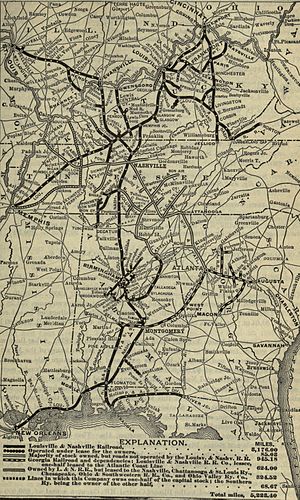This article needs additional citations for verification. (June 2016) |
 | |
 L&N system map, c. 1901 | |
| Overview | |
|---|---|
| Headquarters | Louisville and Nashville Railroad Office Building, 908 West Broadway, Louisville, Kentucky (1907–1980) Seaboard Coast Line Railroad Building, 500 Water Street, Jacksonville, Florida (1980–1982) |
| Reporting mark | LN |
| Locale | Alabama Florida Georgia Illinois Indiana Kentucky Louisiana Mississippi Missouri Ohio Tennessee Virginia North Carolina |
| Dates of operation | 1850–1982 |
| Successor | Seaboard Coast Line Railroad |
| Technical | |
| Track gauge | 4 ft 8+1⁄2 in (1,435 mm) standard gauge |
| Previous gauge | 5 ft (1,524 mm), converted by 1870.[1][2] |
| Length | 10,396 miles (16,731 kilometers) |
The Louisville and Nashville Railroad (reporting mark LN), commonly called the L&N, was a Class I railroad that operated freight and passenger services in the southeast United States.
Chartered by the Commonwealth of Kentucky in 1850, the road grew into one of the great success stories of American business. Operating under one name continuously for 132 years, it survived civil war and economic depression and several waves of social and technological change. Under Milton H. Smith, president of the company for 30 years, the L&N grew from a road with less than three hundred miles (480 km) of track to a 6,000-mile (9,700 km) system serving fourteen states. As one of the premier Southern railroads, the L&N extended its reach far beyond its namesake cities, stretching to St. Louis, Memphis, Atlanta, and New Orleans. The railroad was economically strong throughout its lifetime, operating freight and passenger trains in a manner that earned it the nickname, "The Old Reliable".
Growth of the railroad continued until its purchase and the tumultuous rail consolidations of the 1980s which led to continual successors. By the end of 1970, L&N operated 6,063 miles (9,757 km) of road on 10,051 miles (16,176 km) of track, not including the Carrollton Railroad.
In 1971 the Seaboard Coast Line Railroad, successor to the Atlantic Coast Line Railroad, purchased the remainder of the L&N shares it did not already own, and the company became a subsidiary. By 1982, the Seaboard Coast Line had absorbed the Louisville & Nashville Railroad entirely. Then in 1986, the Seaboard System merged with the C&O and B&O (known as the Chessie System) and the combined company became CSX Transportation (CSX), which now owns and operates all of the former Louisville and Nashville lines.
- ^ Maury Klein (2013). History of the Louisville & Nashville Railroad. University Press of Kentucky. p. 95. ISBN 9780813146751.
- ^ "Mortgages, Charters and Other Documents of the Louisville and Nashville ..." Books.google.com. 1871. Archived from the original on January 29, 2024. Retrieved October 27, 2020.